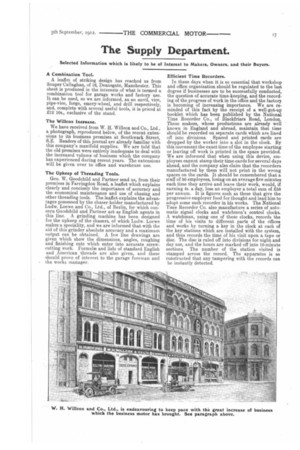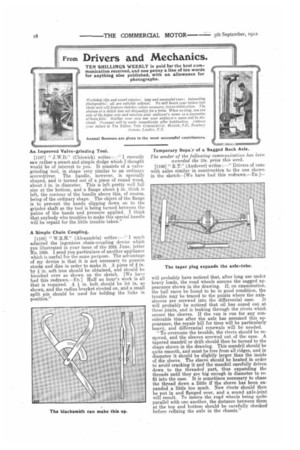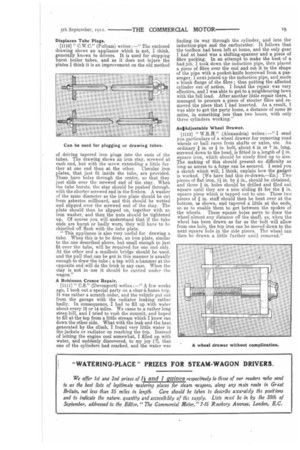The Supply Department.
Page 21

Page 22

Page 23

If you've noticed an error in this article please click here to report it so we can fix it.
Selected Information which is likely to be of Interest to Makers, Owners, and their Buyers.
A Combination Tool.
A leaflet of striking design has reached us from Souper Callaghan, of 16, Deansgate, Manchester. This sheet is produced in the interests of what is termed a combination tool for garage works and factory use. It can be used, so we are informed, as an anvil, vice, pipe-vice, forge, emery-wheel, and drill respectively, and, complete with several useful tools, it is priced at 212 10s., exclusive of the stand, The Wilcox Increase.
We have received from W. H. Willcox and Co., Ltd., a photograph, reproduced below, of the recent extensions to its business premises at Southwark Street, 8 .E. Readers of this journal are already familiar with this company's manifold supplies. We are told that the old premises were entirely inadequate to deal with the increased volume of business which the company has experienced during recent years. The extensions will be given over to office and warehouse use.
The Upkeep of Threading Tools.
Geo. W. Goodchild and Partner send us, from their premises in Farringdon Road, a leaflet which explains clearly and concisely the importance of accuracy and the economical maintenance and use of chasing and other threading tools. The leaflet explains the advantages possessed by the chaser-holder manufactured by Ludw. Loewe and Co., Ltd., of Berlin, for which concern Goodchild and Partner act as English agents in this line. A grinding machine has been designed for the upkeep of the chasers, of which Ludw. Loewe makes a speciality, and we are informed that with the aid of this grinder absolute accuracy and a maximum output can be obtained. A few line drawings are given which show the dimensions, angles, roughing and finishing cuts which enter into accurate screwcutting work. Formula3 and lists of standard English and American threads are also given, and these should prove of interest to the garage foreman and the works manager. Efficient Time Recorders.
In these days when it is so essential that workshop and office organization should be regulated to the last degree if businesses are to be successfully conducted, the question of accurate time-keeping, and the recording of the progress of work in the office and the factory is becoming of increasing importance. We are reminded of this fact by the receipt of a well-got-up booklet which has been published by the National Time Recorder Co., of Blackfriars Road, London. These makers, whose productions are already well known in England and abroad, maintain that time should be recorded on separate cards which are lined off into divisions. Spaced and printed cards are dropped by the worker into a slot in the clock. By this movement the exact time of the employee starting or leaving off work is printed in the space provided. We are informed that when using this device, employees cannot stamp their time-cards for several days ahead, and the company also claim that the recorders manufactured by them will not print in the wrong spaces on the cards. It should be remembered that a staff of 50 employees, losing on an average five minutes each time they arrive and leave their work, would, if earning 4s. a day, lose an employer a total sum of 258 per annum. It is figures such as these that give the progressive employer food for thought and lead him to adopt some such recorder in his works. The National Time Recorder Co. also manufacture a series of automatic signal clocks and watchmen's control clocks. A watchman, using one of thee clocks, records the time of his visits to different parts of the offices and works by turning a key in the clock at each of the key stations which are installed with the system, and thus records the time of his visit upon a tape or disc. The disc is ruled off into divisions for night and day use, and the hours are marked off into 10-minute sections. The number of the station visited is stamped across the record. The apparatus is so constructed that any tampering with the records can be instantly detected.
An Improved Valve-grinding Tool. Temporary Repa:r of a Sagged Back Axle.
[1107] " J.W.D." (Chiswick) writes :—" I recently saw rather a smart and simple dodge which I thought would be of interest to you. It consists of a valvegrinding tool, in shape very similar to an ordinary screwdriver. The handle, however, is specially shaped, and is turned out of a piece of round wood, about 3 in. in diameter. This is left pretty well full size at the bottom, and a flange about in. thick is left, the contour of the handle above this, of course, being of the ordinary shape. The object of the flange is to prevent the hands slipping down on to the grinder shaft as the tool is being turned between the palms of the hands and pressure applied. I think that anybody who troubles to make this special handle will be repaid for the little trouble taken."
A Simple Chain Coupling.
[1108] " W.R.H." (Alexandria) writes :—" I much admired the ingenious chain-coupling device which you illustrated in your issue of the 20th June, letter No. 1066. I send you particulars of another appliance which is useful for the same purpose. The advantage of my device is that it is not necessary to possess stocks and dies in order to make it. A piece of ft in. by / in. soft iron should be obtained, and should be knocked over as shown on the sketch. [We have had this redrawn.—En.] Half an hour's work is all that is required. A 1 in. bolt should be let in, as shown, and the radius bracket riveted on, and a small split pin should be used for holding the links in position."
will probably have noticed that, after long use under heavy loads, the road wheels assume the sagged appearance shown in the drawing. If, on examination, the ball races be found to be in good condition, the trouble may be traced to the points where the axle
sleeves are screwed into the differential case. It will probably be noticed that oil has oozed out at these joints, and is leaking through the rivets which secure the sleeves. If the van is run for any considerable time after the axle has assumed this appearance, the repair bill for tires will be particularly heavY, and differential renewals will be needed.
" To overcome the trouble, the rivets should be removed, and the sleeves screwed out of the case. A tapered mandril or drift should then be turned to the shape shown in the drawing. This mandril should be quite smooth, and must be free from all ridges, and in diameter it should be slightly larger than the inside of the sleeve. The sleeve should be heated in order to avoid cracking it and the mandril carefully driven down to the threaded part, thus expanding the threads until they are big enough in diameter to refit into the case. It is sometimes necessary to chase the thread down a little if the sleeve has been expanded a little too much. New rivetsshould then be put in and flanged over and a sound axle-joint will result. To insure the road wheels being quite parallel with one another, the distance between them at the top and bottom should be carefully checked before refixing the axle in the chassis." Displaces Tube Plugs.
[1110] " C.W.O." (Fulham) writes :—" The enclosed drawing shows an appliance which is not, I think, generally known to drivers. It is used for stopping burst boiler tubes, and as it does not injure the plates I think it is an improvement cm the old method of driving tapered iron plugs into the ends of the tubes. The drawing shows an iron stay, screwed at each end, but with the screw extending a little further at one end than at the other. Circular iron plates, that just fit inside the tube, are provided. These have holes through the centre, so that they just slide over the screwed end of the stay. When the tube bursts, the stay should be pushed through, with the shorter screwed end in the firebox. A washer of the same diameter as the iron plate should be cut from asbestos rnillboard, and this should be wetted and slipped over the screwed end of the stay, The plate should then be slipped on, together with an iron washer, and then the nuts should be tightened up. Of course you will understand that if the tube ends are burnt or badly worn, they will have to be chiselled off flush with the tube plate.
"This appliance is also very useful for drawing a tube. When this is to be done, an iron plate, similar to the one described above, but small enough to just fit over the tube, will be required for one end only. At the other end a rnudhole bridge should be used, and the pull that can be got in this manner is usually enough to draw the tube ; a tap with a hammer at the opposite end will do the trick in any case. When the stay is not in use it should be carried under the wagon."
A Robinson Crusoe Repair.
[1111] " 0.5." (Devonport) writes:—" A few weeks ago, I took out a special party on a char-h, banes trip. It was rather a scratch order, and the vehicle put out from the garage with the radiator leaking rather badly. In consequence, I had to fill up with water about every 12 or 14 miles. We came to a rather long steep hill, and I tried to rush the summit, and hoped to fill at the top from a little stream which I knew ran down the other side. What with the leak and the heat generated by the climb, I found very little water in the jackets or radiator on reaching the top. Instead of letting the engine cool somewhat, I filled up with water, and suddenly discovered, to my joy (?), that one of the cylinders had cracked, and the water was finding its way through the cylinder, and into the induction-pipe and the carburetter. It follows that the toolbox had been left at home, and the only gear I had at hand was a shifting-spanner and a piece of fibre packing. In an attempt to make the best of a bad job, I took down the induction pipe, then placed a piece of fibre over the end and cut it to the shape of the pipe with a. pocket-knife borrowed from a passenger. I next joined up the induction pipe, and made a blank flange of the fibre ; thus putting the affected cylinder out of action. I found the repair was very effective, and I was able to get to a neighbouring town with the full load. After another little repair there, I managed to procure a piece of stouter fibre and removed the piece that I had inserted. As a. result, I was able to get the party home, a distance of some 20 miles, in something leas than two hours, with only three cylinders working."
AnjAdjustable Wheel Drawer.
[1112] " W.R.H." (Alexandria) writes :—" I send you particulars of a wheel drawer for removing road wheels or ball races from shafts or axles, etc. An ordinary in. or * in. bolt, about 6 in or 7 in. long, screwed down to the head, is fitted in a length of tin. square iron, which should be nicely filed up to size. The making of this should present no difficulty as long as access to a forge can be secured, I send you a sketch which will, I think, explain how the gadget is worked, [We have had this re-drawn.—En.1 Two pieces of flat iron, 11 in. by in., should be obtained, and three in. holes should be drilled and filed out square until they are a nice sliding fit for the I in_ square piece which is tapped out to size. These two pieces of -a in. stuff should then be bent over at the bottom, as shown, and tapered a little at the ends, so as to enable them to get between the spokes of the wheels. These square holes serve to draw the wheel almost any distance off the shaft, as, when the wheel has been drawn as far as the bolt will allow from one hole, the top iron can be moved down to the next square hole in the side pieces. The wheel can then be drawn a little further until removed."
























